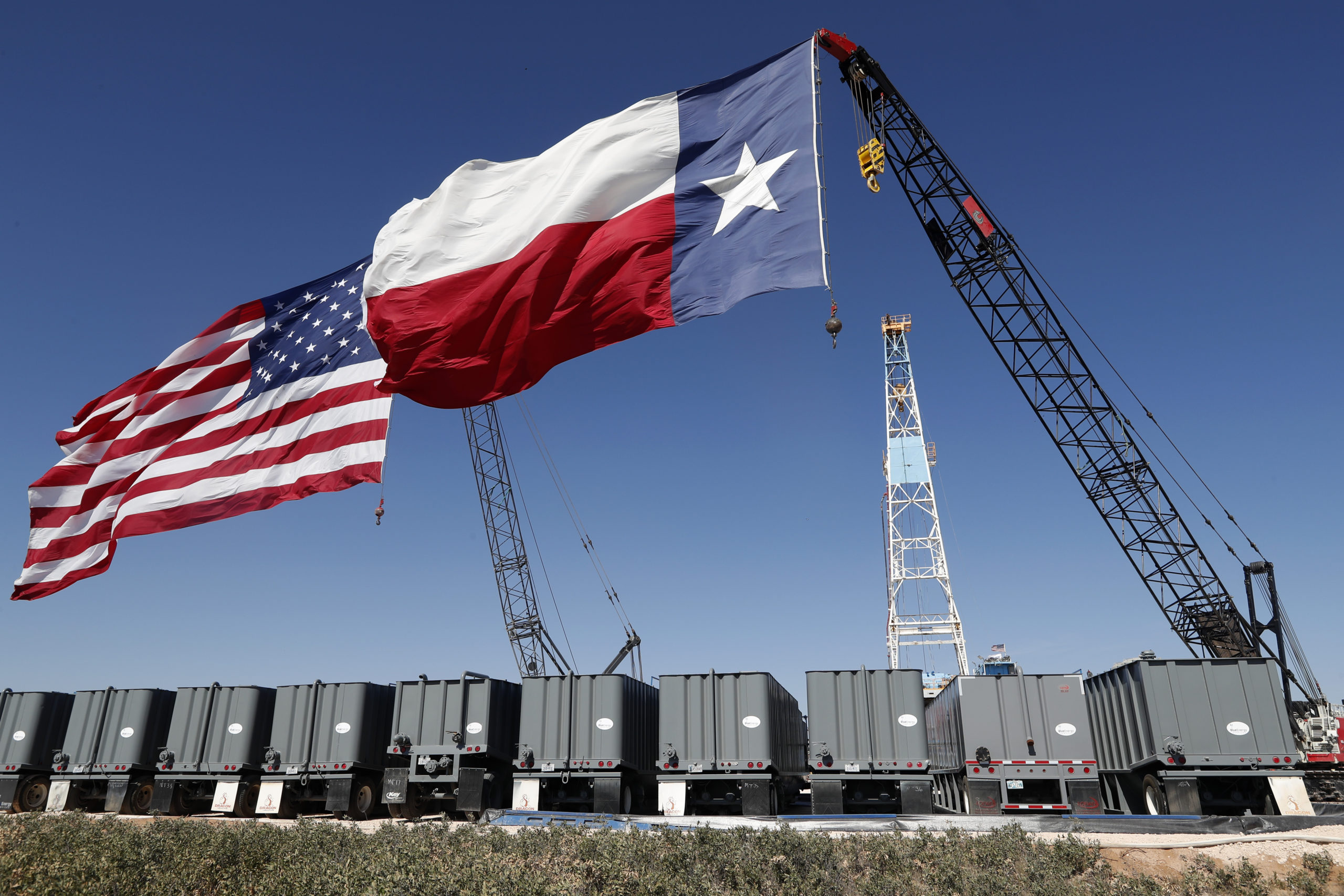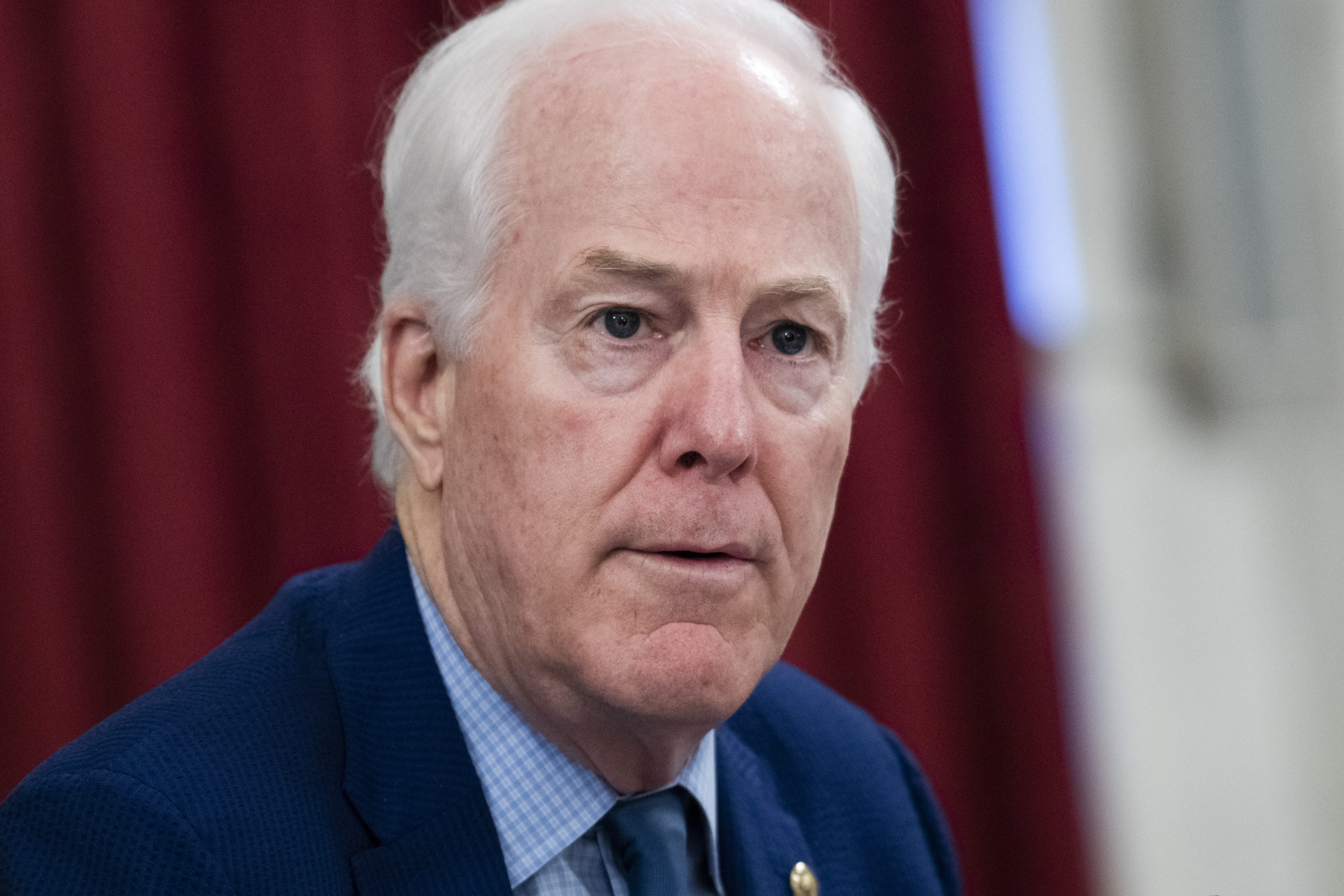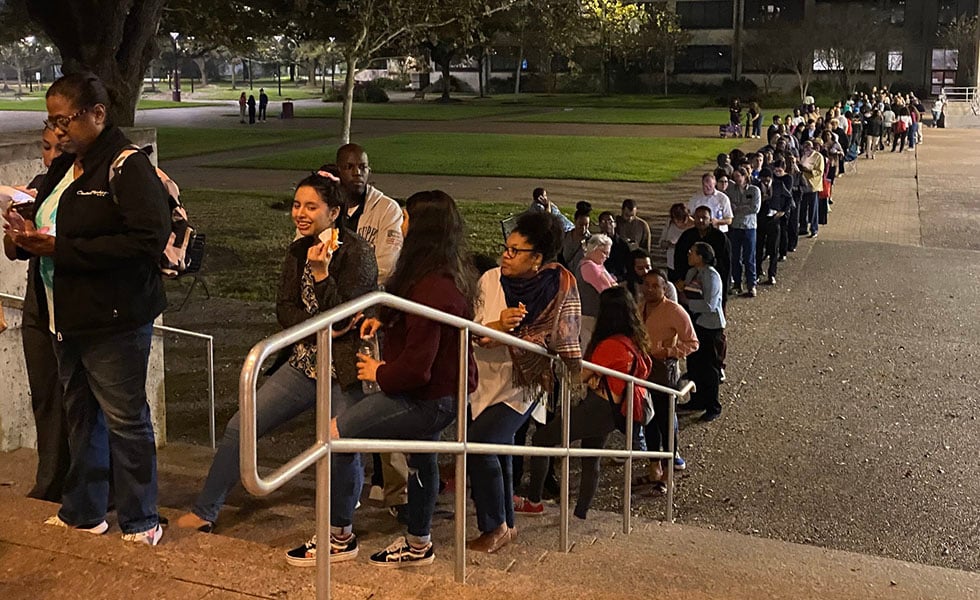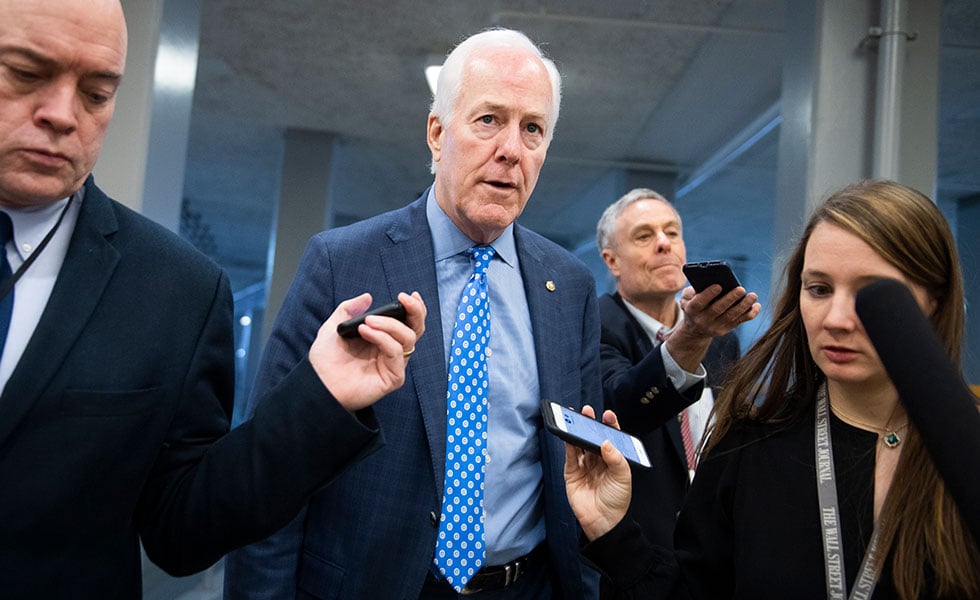
Rural Voters Stepped on the Gas for Trump Across the Texas Oil Patch
Even in Democratic strongholds, some voters in the state’s vast shale plays were afraid of Joe Biden’s energy platform.
Above: Flags fly from the tops of cranes near the site where President Donald Trump delivered remarks about American energy production during a visit to an oil rig in Midland.
Once again, rural Texans voted en masse for President Donald Trump in 2020. Joe Biden spent no time campaigning in Texas and thus failed to reach the large swath of counties populated by some of the most conservative voters in the nation. It’s no surprise the president-elect did poorly here. But rural Texas’ repudiation of Biden was especially severe in two of the state’s largest oil and natural gas producing areas, places where Democrats have otherwise found some success. Local leaders say it’s a sign that Biden’s messaging on environmental issues didn’t work in the oil patch—and that Trump’s did.
Texas is home to two of the most productive oil fields in the United States. The Permian Basin, a shale play that stretches from West Texas into New Mexico, produces roughly 4 million barrels of crude a day. The smaller Eagle Ford Shale spans 26 counties from Central Texas to the U.S.-Mexico border. The two areas, combined with other oil and gas plays in Texas, account for nearly $10 billion in annual revenue and taxes and 1.8 million jobs. Much of the windfall comes courtesy of hydraulic fracturing, or “fracking,” which has unleashed vast reserves of oil and gas throughout the state.
People who live in the Permian and Eagle Ford are fairly conservative, but they aren’t reliably Republican, in part because of the voting history of the counties’ sizable Latino and Tejano base. For example, Hillary Clinton won La Salle County in South Texas with 56 percent of the vote in 2016. She won Reeves County in West Texas with 54 percent. Both are big players in Texas’ oil boom. Biden lost both.
Trump won in 56 of the 59 Texas counties classified as most affected by drilling activities in the Permian Basin.
An Observer analysis of election results shows that counties in these two oil fields were more likely to vote for Trump in 2020 than they were four years ago. Trump won in 56 of the 59 Texas counties classified as most affected by drilling activities in the Permian Basin. In the three counties Biden did win in these areas (Culberson, Presidio, and urban El Paso), Trump still took a larger percentage of the vote than in 2016. In the Eagle Ford, Biden took only four of the 27 counties; Trump managed to flip two counties that Clinton won in 2016.
As part of his Green New Deal, Biden says he hopes to achieve a “100 percent clean energy economy” and net-zero carbon emissions by 2050, and says he will end new fracking leases on public land. Biden’s campaign also said it would not accept financial contributions from the oil and gas sector. The president-elect’s goals go further than any president before him, says Luke Metzger, executive director at Environment Texas, a nonprofit based in Austin. “It’s a step forward for Democrats as far as environmental stewardship, as far as protecting natural resources,” Metzger says.
Rural voters in oil-producing areas understandably weren’t thrilled with Biden’s stated plans to move away from fossil fuels toward renewable energy. But in the weeks leading up to the election, the Trump campaign exaggerated the extent of Biden’s environmental platform, saying he wanted to ban all fracking, not just new activity on public land. At a rally in Pennsylvania, Trump told a crowd of supporters, “The Democrat Party hate[s] fracking… They hate American energy and Joe Biden will shut it all down.” Vice President Mike Pence said at a televised debate in October that Biden planned to “ban fracking,” which is misleading.
“The Republicans played it up big time. They hit heavily on the misinformation of Biden doing away with fracking.”
Trump’s message apparently hit home with voters in Texas’ vast oil patches. In Pecos County, a West Texas county between New Mexico and the U.S.-Mexico border, the rumor that Biden planned to ban fracking rankled many residents, according to County Judge Joe Shuster. Pecos County went for Trump in 2016, too, but swung 9 percentage points further in his favor this year. That’s surprising in a county with only three Republican elected officials. (Shuster himself is a fifth-term Democrat.) “The Republicans played it up big time. They hit heavily on the misinformation of Biden doing away with fracking,” Shuster said. He tried to dispel the myth to some voters who mentioned it before Election Day, clarifying that the ban only applied to public lands, but “the damage was already done.”
He said that people in the county don’t always like how Trump talks or acts, but most are connected to the petroleum industry in one way or another and saw Biden as a threat to their livelihoods. Neighboring Reeves County flipped red by a massive margin of 12 points, likely for the same reason.
Another county that flipped from blue to red in 2020 was La Salle County, which has served as the locus of some of the most intense fracking efforts in the Eagle Ford. People there also fear that Biden’s promise to speed the development of alternative forms of energy could snuff out the oil and gas industry their economy relies on, says County Judge Joel Rodriguez, Jr., a Democrat. The county, which generally votes blue, hasn’t voted for a Republican president since George W. Bush was on the ticket. But this time around, Rodriguez said some local oil and gas employers were telling workers that their jobs might depend on a vote for Trump.
“We heard quite a few people talking that the oil field would go away if Biden wins,” Rodriguez says. “The reality is the whole world is using fossil fuels and it will take a while before those technologies can be implemented.”
“We heard quite a few people talking that the oil field would go away if Biden wins. The reality is the whole world is using fossil fuels and it will take a while before those technologies can be implemented.”
It might have helped if the Biden campaign had visited South Texas or the Permian Basin to explain its plans and reach out to voters. Its failure to do so appears to be a big reason that the reliably blue Rio Grande Valley, south of La Salle, also revolted against Biden.
Gaelan Frazier, the chair of Republican Party in Frio County, says talk of a fracking ban or limits on drilling activities contributed to drumming up votes in this reliably blue county. It’s usually hard to convince locals to go to the polls—turnout in Frio usually peaks around 30 percent—but this year it reached more than 50 percent. Underlying the increased turnout, Frazier says, was “fear of losing jobs if the oil industry gets cut.” But Frazier also said he thought this fear wasn’t the dominant factor driving voters. He said voters in the county were also concerned about signs of unrest this summer, including the Black Lives Matter protests in nearby San Antonio and the movement to defund the police. Trump won 54 percent of the vote in Frio County, up 11 percent from 2016.
The pro-Trump trend carried north up the border to Culberson County, which voted 63 percent for Clinton four years ago and only 51 percent for Biden this year. Dan Baeza, the county’s fresh-faced Democratic Party chair, says the county’s residents generally aren’t engaged in national politics. And on the local and state levels, Democrats reign here—there are no Republican elected officials in the county. The population is 73 percent Hispanic, a demographic that was thought before this election to be solidly blue. There isn’t even a local Republican Party chair in Culberson County.
But this election was different. Baeza, who has served as the county’s Democratic Party chair since last year, says voters were in a tizzy over a local mask mandate ordered by the Democratic county judge. Residents of Van Horn, including Baeza’s neighbor, flew Trump flags in front of their homes. As in other oil field counties, chatter on social media indicated that the people of Culberson County thought that Biden would tank the petroleum industry that is the lifeblood of the community.
“There was a strong movement for President Trump,” says Rodriguez, the La Salle County judge who has been active in state politics for decades. “I don’t think the Biden campaign spent a lot of money in trying to get the Democratic vote out; it was kind of like they wrote us off.”
Read more from the Observer:
-
Bringing the Dead Home: Thirty years after Congress passed the Native American Graves Protection and Repatriation Act, only a fraction of human remains held by Texas’ museums and universities have been returned.
-
How We Got Here: Texas’ health system has been underfunded, understaffed, and unprepared for years. Here, COVID-19 found the perfect place to spread.
-
Local Organizers Explain the Republican Surge in South Texas: Democrats have long taken Latino voters for granted, while Republicans have worked to fill that organizing void.


